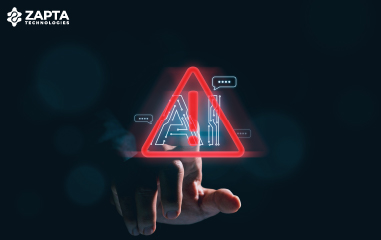Every company wants a slice of the Generative AI pie but few know what they’re actually ordering
Generative AI has created this hype, a promise of efficiency gains, cost savings, and new revenue streams. Every other business is racing to add the shining “AI Powered” tag next to their name.
But no one’s asking the important questions. Like,
How many of those “AI-powered” things are actually powered by results?
Which business processes are truly benefiting from it?
And can every business really get value out of Generative AI?
Because when your AI experiment fails, it not only affects your budget, it hurts your credibility and momentum as well. And recovering from such a loss isn’t easy.
Can Generative AI Really Solve Business Problems or Is It Just Hype?
ZAPTA Technologies isn’t here to discourage you from adopting AI but to give you a reality check. To remind you that success with Generative AI doesn’t come to those who chase hype. It’s for those who approach it intentionally, strategically and measurably.
In this blog post, we’ll unpack if generative AI can actually solve your business problems and, if it can, where it creates the most impact and how to approach it the right way.
Why Everyone’s Talking About Generative AI But Few Get It Right
Generative AI is being discussed in every boardroom discussion, investor calls, and product launches in 2025.
You’ve probably seen it too, as every brand suddenly wants to be “AI-powered.” Why? Because it sounds good. It sells. It signals innovation.
They believe it will magically bring productivity, lower their costs, and create new revenue streams.
But more than that, they’re afraid of missing out on something everyone else seems to be doing. Businesses aren’t chasing AI because they fully understand it; they’re chasing it because they can’t afford not to.
Here’s why most companies, maybe even yours, are going after “Generative AI”:
The pressure to stay relevant: When your competitors start showcasing “AI-powered” tools, you feel the pull to follow too, not necessarily out of strategy, but survival. No leader wants to look like they’re behind on innovation.
Investor and customer expectations: Investors, clients, and even your own team want to see that you’re exploring AI even if the plan isn’t fully clear yet. The market rewards visibility more than strategy.
The accessibility illusion: Tools like ChatGPT, Gemini, and Claude have become mainstream, making you believe that adopting AI is as simple as plugging in a model. That illusion drives quick, surface-level adoption but not always impact.
The buzzword effect: Many executives talk about Generative AI without really knowing what it does, how it fits into their workflow, or whether it should even be there.
Most of the time, decision makers are watching the trend but not researching its impact. The failure rate of AI is brutal
A 2024 MIT report found that 95% of generative AI projects fail to deliver measurable ROI. Why? Because businesses chase the buzz, not the blueprint. They never built the strategy that makes it work.
Top Areas Where Generative AI Is Creating Measurable Business Impact
Now, let’s look at some real-life use cases of generative AI in business processes where it has brought meaningful ROI,
Internal knowledge and documentation
Did you know employees spend almost two hours every day searching for specific internal information and still only find what they need about half the time? That’s a huge productivity loss!
Generative AI changes this as one of its biggest, most practical wins, is retrieving information. Instead of wasting hours digging through wikis, Slack threads, or folders, your team can get instant answers from an AI assistant trained on your company’s own knowledge base.
You can build your own company-specific retrieval-augmented generation (RAG) chatbots to turn scattered information into an organized, searchable system. And GenAI will help you find and summarize policies, codebases, processes, or client history instantly and conversationally.
This is the kind of transformation that doesn’t make flashy headlines but translates directly into productivity gains. If you’re in sectors like consulting, finance, healthcare, or SaaS, this is one of the highest-ROI areas to start with.
Customer insights and decision intelligence
Every business sits on a mountain of unstructured data (customer calls, chat transcripts, emails, feedback forms). This data is gold, packed with signals about what your customers actually want. But the problem is, it’s almost impossible to go through all of it manually and extract insights that matter.
With the help of Generative AI, you can analyze thousands of customer conversations in minutes. It can spot trends, gaps, and opportunities in your business that your support or sales team might’ve missed.
One developer even shared in a Reddit thread how he used AI to analyze over 100,000 customer call transcripts. The entire setup cost less than $4,000, but the insights uncovered helped his company create a new offering that now brings in over $100,000 in recurring monthly revenue.
That’s how you use Generative AI strategically and turn your overwhelming data into business intelligence in a way that actually brings growth. Industries like SaaS, telecom, finance, and e-commerce stand to benefit the most from this kind of insight-driven decision-making.
Creative and marketing cost reduction
One company shared how they used AI to generate the kind of marketing visuals, animations, and website icons that once required a 20-person design department and half a million dollars a year in freelancer costs.
Now, just two AI-savvy marketers handle the same output — producing more, faster, and at a fraction of the cost. That’s the new creative model: smaller, smarter teams equipped with powerful AI tools, capable of delivering enterprise-level production without the enterprise-level budget. This shift is most impactful for marketing agencies, startups, e-commerce brands, and media companies looking to scale content creation efficiently.
Apart from these areas, Generative AI’s impact can be seen in other parts of your business, such as;
Streamlining manual, repetitive tasks such as report generation, invoice processing to save hours every week.
Helping developers write, review, and debug code faster, improving software delivery speed.
Translating documentation and automating multilingual communication for global teams and customer support.
Where Generative AI Fails and Why Most Businesses Get It Wrong
Not every business needs an AI-shaped solution.
Right now, a lot of companies are rushing to sprinkle “Generative AI” across their products adding chatbots, content generators, or AI buttons just to look innovative. It’s the classic “everyone else is doing it, so we should too” mindset, and this happens with every technological breakthrough..
What business leaders need to understand is that looking modern isn’t the same as being effective. Many of these features sound impressive in press releases, but don’t actually solve real customer problems. Sometimes, the simplest automation or workflow fix delivers better results than a flashy AI solution.
Don’t take generative AI as a magic feature. It’s a business enabler when applied with intent, not impulse. Adopt it only if it fixes a real pain point, improves efficiency, or creates measurable impact.
How to Know If Generative AI Makes Sense for Your Business
Next time you get the urge to add a new AI tech to your business, think about these questions;
- Is there a clearly defined problem to solve?
Start with the “why.” If you can’t name a specific pain point, you’re not ready to implement AI yet.
- Does AI provide a measurable improvement in cost, time, or revenue?
You should be able to say, “This will save us X hours or increase Y conversions.” If not, it’s a no.
- Can your team maintain and scale the system?
Many AI pilots fail because there’s no plan for long-term upkeep or integration with existing workflows.
- Can you quantify ROI over time?
Set clear metrics, whether that’s reduced manual work, faster delivery, or higher customer satisfaction.
- Are you solving a user need or chasing a trend?
This is the big one. If your motivation is to “add AI” because it sounds modern, pause. Start where it truly makes a difference.
Generative AI makes sense when it has a purpose, a measurable outcome, and a sustainable plan behind it. The easiest way to know if AI makes sense for your business is to start small. Identify one area where automation or intelligence could make the biggest impact, test it, and measure the results.
And if you’re still unsure, turn to ZAPTA Technologies
At ZAPTA Technologies, we help businesses cut through the noise and get to what actually matters. We’re a U.S.-based custom AI software development company specializing in Generative AI, chatbots, and workflow automation. But what sets us apart isn’t just what we build, it’s how we approach it.
Before we write a single line of code, our team analyzes your workflows, data, and business goals to find where AI can make a tangible impact. Sometimes, that means recommending a ready-made API or automation instead of a costly custom build, because our goal is your success, not our billables.
For businesses ready to integrate AI responsibly, strategically, and profitably, ZAPTA Technologies is where to start. Because we don’t chase trends, we set them up for success.

















